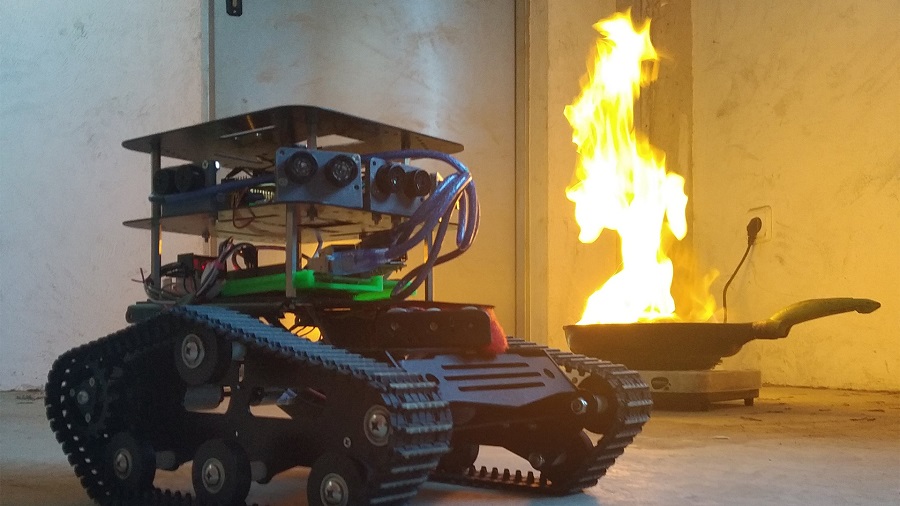Newsroom
When a fire breaks out inside a building, firefighters are often unaware of the dangers that can be found there. In the future, small ground robots could recognize these environments to detect the sources of fire or the toxicity of the environment, as well as locate possible victims and safe routes to access them.
Now, researchers from the Rey Juan Carlos University (URJC) and the Autonomous University of Madrid (UAM) have created a prototype robot capable of performing these functions in real fires.
El work has recently been published in the Journal of Field Robotics, one of the most prestigious magazines in the field of robotics that focuses on the application of robots in real scenarios.
risk operations
Fire fighting professionals often say that “the best fire is the one that doesn't break out”. Therefore, preventing the causes of a fire, predicting its evolution and avoiding its lack of control is key to being able to extinguish it.
When firefighters respond to an interior fire they have to face several challenges. One of the biggest problems is the lack of information about the setting, as well as the objectives and dangers found inside.
On some occasions, they do not have plans of the buildings; in others, the fire has been able to radically change them, for example, generating debris in the access roads or toxic atmospheres in certain places.
In these operations, firefighters must make important decisions based on limited information, which can increase the risk of accidents in the short term or occupational diseases in the long term.
The idea of the URJC and UAM researchers is not that robots replace the people who carry out these jobs, but that they support, protect and empower them during their interventions, as shown in This Video.
To do this, they propose that their robot intervene before the firefighters, using its sensors to collect information about the scene and the fire, such as temperature, air quality, etc.
More responsibilities
In addition, the robot can carry one or more normal or thermal cameras to help locate flames and victims, making it easier for firefighters to plan faster interventions with less risk.
"In the future, robots such as the one developed could assume more responsibilities in tasks such as extinguishing the fire itself, the search and rescue of the victims, the mitigation of certain dangers, the prediction of the evolution of the flames, the structural analysis of the building or the transport of materials”, declare the authors.
To carry out these milestones, the researchers have designed a low-cost, but high-performance, modular robot capable of manually monitoring the terrain or performing autonomous exploration calculating fast and safe routes to its objectives.
The robot is equipped with ultra-broadband beacons and ultrasonic sensors to locate itself and detect obstacles. Sensors have also been installed to measure temperature, relative humidity and air quality (eCO2, TVOC, H2 and ethanol). “These measurements are sent in real time to the base station and are recorded in a database, to measure the environmental conditions of the fire, detect the location of the fire source accurately and allow firefighters to make the most appropriate decisions. in each case”, detail the researchers.
In addition, the team has developed a realistic robot simulator and several intervention environments that allow mission preparation and training of operators before interventions with the real robot. In this way, routes to places of interest can be planned, certain dangers present on the scene can be anticipated, and intervention times can be estimated.
Finally, the researchers carried out a series of experiments in conditions similar to real fires at the facilities of the Alcorcón Fire Department. During these tests, the team was able to demonstrate the ability of their robot to work in an unstructured setting with the presence of fire and smoke.

The idea of the URJC and UAM researchers is not that robots replace the people who carry out these jobs, but that they support, protect and empower them during their interventions. / URJC-UAM.
Financing:
HelpResponder - Research platform for the support, guidance and monitoring of services for prevention, risk control, security and indoor evacuation—financed by the Community of Madrid and the Universidad Rey Juan Carlos, UBICA2 (TSI-100105-2014-196). Work produced with the support of a 2020 Leonardo Grant for Researchers and Cultural Creators, BBVA Foundation. The Foundation takes no responsibility for the opinions, statements, and contents of this project, which are entirely the responsibility of its authors. This work is partially funded under Project PID2021-126592OB-C22 funded by MCIN/AEI/


